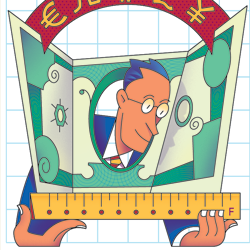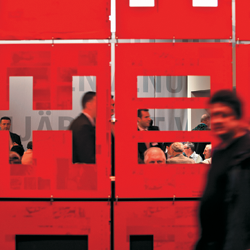Before shipping boxes of collateral literature to your next show, consider these cost-effective digital options. By Candy Adams

t my first trade show in 1991, the company I was working for had shipped cartons of expensive, glossy, four-color, tri-fold product brochures to the convention center to distribute in the booth. Every time I walked by the reception desk, I'd grab a few brochures out of the box under the counter and meticulously fan out a handful on the countertop for passersby to pick up. And when I'd come back just a few minutes later, there would be one lonely brochure left on the counter. Traffic was slow, and I couldn't imagine how we were going through that many brochures so quickly. Then I caught on. For every six brochures I put out, my boss walked by behind me and put five back under the counter. When I asked him why, he said, "Do you know that putting those brochures out on the counter is like laying dollar bills out there for just anyone to take?"
This made absolutely no sense to me. We were spending more than $100,000 to exhibit at the show, which had about 5,000 total attendees. Of those, 10 percent comprised our target market. We had just designed, printed, and shipped 1,000 new brochures to the trade show, and I thought the idea was to hand them out at the show – silly me. But there was my boss, stressing about the dollar brochure ending up in the hands of a potentially unqualified, but not disinterested, booth browser.
As an industry neophyte, I'd never really thought about the reasoning behind – and method of – handing out marketing brochures to educate show attendees about a product line. Nor did I know that it could be such a complex issue that turned out to be based on my boss' corporate frugality.
Fast forward 20 years, and I've come a long way from schlepping heavy cartons of printed literature to trade shows and playing hide-the-brochures with my boss. Hard copies of catalogs, brochures, and spec sheets haven't disappeared totally from the show floor, but exhibitors have pared down the amount they ship, due in part to attendees' tendency to ditch it. In fact, according to a stat from The Global Association of the Exhibition Industry, 65 percent of all hard-copy materials distributed at trade shows ends up in garbage bins almost immediately. I was shocked the first time I heard this statistic and learned that hotels actually bring in additional dumpsters during trade shows just to accommodate the influx of show-related trash left behind in the guest rooms.
Exhibit managers also got wise to the fact that after each and every show, they were disposing of cartons full of obsolete show-specific printed materials and dog-eared sales literature. It's not exactly an environmentally friendly scenario, even if the literature was printed on recycled paper with soy-based ink and is recycled by the general service contractor or venue. Needless to say, those cartons represented a lot of waste – and wasted dollars.
Another reason propelling the shift from printed literature to digital distribution is the astronomical rise in material-handling costs. According to the Exhibit and Event Marketers Association (E2MA) Advocacy Committee, material-handling fees increased 257 percent from 1996 to 2003, making it the fastest-growing cost amid all exhibit services. So while designing, printing, and shipping marketing materials is expensive, nothing says "wasted budget" like paying round-trip drayage for a one-way move of brochures from the convention-center docks to your booth. And speaking of rising prices, don't forget the airlines' checked-baggage fees that are making attendees more reluctant to fill their suitcases with heavy collateral.
If you're looking for alternates to printed literature, you don't have to go cold turkey and adopt a strict digital-only distribution method. Here are several tactics you can employ to avoid shipping boxes of brochures to your next show.
Value-Added Business Cards
Print business cards featuring a show-specific URL that leads to a landing page from which press kits, spec sheets, product brochures, etc. can be downloaded and printed. The good news with this option is that attendees have a tendency to not sort through business cards and discard them until they are back in their offices, giving your collateral a better chance of post-show survival. That said, make sure the card includes a compelling call to action, such as a free white paper or a limited-time product discount, to reward people for taking the time to visit the website.
Reusable Flash Drives
Load all of your marketing materials onto a branded flash drive that doubles as a giveaway. You can put myriad files onto flash drives, such as PDFs, photos, PowerPoint presentations, videos, etc. There is a chance that recipients will just wipe the content and repurpose it, but its utility gives it more staying power than a print catalog that's more likely to get dumped in the trash if recipients' bags are a pound or two overweight. Plus, if the drive features your logo and Web address, it keeps you top of mind and top of desk long after the trade show is over.
| According to a stat from The Global Association of the Exhibition Industry, 65 percent of all hard-copy materials distributed at trade shows ends up in garbage bins. |
Proximity Marketing
Employ Quick Response (QR) codes or Near Field Communication (NFC) technology in your exhibit to allow attendees access to marketing materials and additional information. Those that have QR-code scanners on their smartphones and tablets can simply scan a code that then links to product brochures, videos, photos, websites, etc. NFC-enabled devices are becoming standard, but there's no guarantee that every visitor will have the technology necessary to get marketing materials via this distribution method. So if you incorporate NFC into your exhibit, it's a good idea to have a backup plan such as a handful of hard-copy brochures or the aforementioned business cards.
Interactive Kiosks
Provide tablet kiosks in your exhibit loaded with literature, product demonstrations, and videos for visitors to peruse at their leisure. Also include a method through which they can request more information or event-specific literature. This could be as simple as clicking a button on screen or filling out a form that collects contact information. The benefit of this method is that it allows visitors to send themselves product materials without the need to engage with your exhibit staff, which can be especially helpful if you're understaffed. It also facilitates the capture of qualifying data for post-show follow-up.
Lead-Retrieval Systems
Use either the show's official lead-retrieval system or a third-party system that allows visitors to request literature follow-up and select the information they'd like to receive. They can also state their delivery preference. Some people might opt for an attachment sent via email, while others prefer a clickable link or even a hard copy mailed to their office.
Post-Show Email
Distribute literature after the trade show as part of the standard follow-up process, using hyperlinks in your "thank you for visiting" email. I believe that any reason to follow up with booth visitors after the show is a good one, and delivering promised literature gives you a very valid reason. Plus, sending out electronic literature after the deluge of materials gathered on site has been dealt with makes your content stand out.
In addition to reducing shipping and material-handling costs, the aforementioned digital-distribution options can also save you time and money when it comes to fixing errors and updating content. For example, instead of going back to the printer to modify a file for hard-copy materials, you can often update the marketing collateral in a flash, adding current photos, show-specific information, new product lines, updated pricing, and much more – and that flexibility is priceless.




 t my first trade show in 1991, the company I was working for had shipped cartons of expensive, glossy, four-color, tri-fold product brochures to the convention center to distribute in the booth. Every time I walked by the reception desk, I'd grab a few brochures out of the box under the counter and meticulously fan out a handful on the countertop for passersby to pick up. And when I'd come back just a few minutes later, there would be one lonely brochure left on the counter. Traffic was slow, and I couldn't imagine how we were going through that many brochures so quickly. Then I caught on. For every six brochures I put out, my boss walked by behind me and put five back under the counter. When I asked him why, he said, "Do you know that putting those brochures out on the counter is like laying dollar bills out there for just anyone to take?"
t my first trade show in 1991, the company I was working for had shipped cartons of expensive, glossy, four-color, tri-fold product brochures to the convention center to distribute in the booth. Every time I walked by the reception desk, I'd grab a few brochures out of the box under the counter and meticulously fan out a handful on the countertop for passersby to pick up. And when I'd come back just a few minutes later, there would be one lonely brochure left on the counter. Traffic was slow, and I couldn't imagine how we were going through that many brochures so quickly. Then I caught on. For every six brochures I put out, my boss walked by behind me and put five back under the counter. When I asked him why, he said, "Do you know that putting those brochures out on the counter is like laying dollar bills out there for just anyone to take?"



